Upwind 360
The Upwind 360 is a fun and seamless freestyle maneuver that I recommend learning because there is very little risk and it can be performed on almost any size board in light, medium, or strong winds. However keep in mind, smaller boards and windier conditions will demand more mastery, experience, and command of this maneuver. The ideal learning ecosystem will be a slightly larger board with wind speeds that are light to moderate.
Learning this maneuver improves your general freestyle capabilities because it builds and reinforces fundamental skills that can be helpful for learning other moves. In other words, the skills are transferable and extensible. These fundamental skills include sail control while backwinding the sail, body positioning while leaning over the nose of the board, and hand/arm adjustments to steer and control power in your sail.
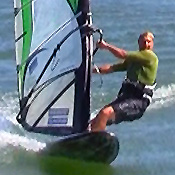
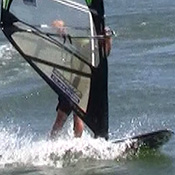
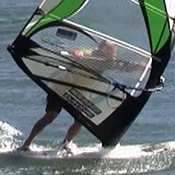
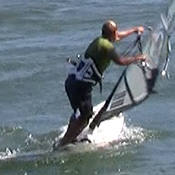
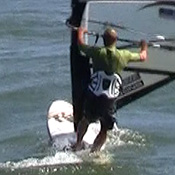


Rider: Royn Bartholdi
Steps
 1)
Initiate this maneuver by heading slightly off the wind (on a soft beam reach) to gather as much speed as possible. Then oversheet the sail (this means moving the sail back so the clew is closer to the tail and the gap between the board tail and the clew is smaller; do this while sheeting in with the clew hand). Keep sheeting in with the clew hand and keep the front arm extended but across your chest and looking forward into the wind. This will cause the board to carve upwind. Be aggresive! However, remember to think safety first and make sure there are no sailors upwind when you are trying this maneuver, especially sailors who are charging full speed into a jibe. In other words, take precautions to avoid collisions.
1)
Initiate this maneuver by heading slightly off the wind (on a soft beam reach) to gather as much speed as possible. Then oversheet the sail (this means moving the sail back so the clew is closer to the tail and the gap between the board tail and the clew is smaller; do this while sheeting in with the clew hand). Keep sheeting in with the clew hand and keep the front arm extended but across your chest and looking forward into the wind. This will cause the board to carve upwind. Be aggresive! However, remember to think safety first and make sure there are no sailors upwind when you are trying this maneuver, especially sailors who are charging full speed into a jibe. In other words, take precautions to avoid collisions.  2)
The board will slow down and begin to stall. As the board stalls then bring the rig foward toward the wind. By forward I mean move the mast (the leading edge of your rig) into the wind. This is accomplished by lifting up with the clew hand and extending the front arm forward (the bow and arrow position). At this point the nose of the board is into the eye of the wind.
2)
The board will slow down and begin to stall. As the board stalls then bring the rig foward toward the wind. By forward I mean move the mast (the leading edge of your rig) into the wind. This is accomplished by lifting up with the clew hand and extending the front arm forward (the bow and arrow position). At this point the nose of the board is into the eye of the wind.  3)
While keeping your body over the centerline of the board, keep extending the front arm and leaning foward. Perform this in a controlled and steady manner so you are balanced and do not fall into the water. The back side of the sail will eventually be presented to the wind. When first learning this maeuver the body position will feel really awkward because you are way over the front of the board. This may be a new feeling for you in relation to your sail and board.
3)
While keeping your body over the centerline of the board, keep extending the front arm and leaning foward. Perform this in a controlled and steady manner so you are balanced and do not fall into the water. The back side of the sail will eventually be presented to the wind. When first learning this maeuver the body position will feel really awkward because you are way over the front of the board. This may be a new feeling for you in relation to your sail and board.  4)
The nose of the board will start to swing around to the new tack. This is because the sail is forward and the force of the wind (the center of effort) on the sail (albeit from the backside) is in front of the mast base. Keep the front arm extended as the board swings and look into the direction of the maneuver. At this point, the hand on the clew will be your main control mechanism whereby pushing the clew away from your body or pulling the clew toward your body (more like collapsing since you are backwinded) will control the power and direction of power in the sail. This is where you learn the finesse in the maneuver.
4)
The nose of the board will start to swing around to the new tack. This is because the sail is forward and the force of the wind (the center of effort) on the sail (albeit from the backside) is in front of the mast base. Keep the front arm extended as the board swings and look into the direction of the maneuver. At this point, the hand on the clew will be your main control mechanism whereby pushing the clew away from your body or pulling the clew toward your body (more like collapsing since you are backwinded) will control the power and direction of power in the sail. This is where you learn the finesse in the maneuver.  5)
As the board continues to swing, your body weight will slowly move back from the nose so you can maintain balance with the changing forces on the sail. You can now push the clew through the eye of the wind and pull a little with the front arm so the mast becomes more vertical.
5)
As the board continues to swing, your body weight will slowly move back from the nose so you can maintain balance with the changing forces on the sail. You can now push the clew through the eye of the wind and pull a little with the front arm so the mast becomes more vertical.  6)
The sail will power up with your back to the wind and rotate through the remainder of the maneuver.
6)
The sail will power up with your back to the wind and rotate through the remainder of the maneuver.  7)
Adjust and sail away.
7)
Adjust and sail away. Videos
Loading the player ...
Perform this maneuver in the straps and planing on a slight beam reach. Oversheet the sail (racking it back toward the tail) so the board turns upwind and stalls. Throw the sail forward and lean out over the nose to backwind the sail. Keep the sail away from your body and the board will begin to rotate as you get backwinded. As the board rotates, progressively lean back toward the tail of the board letting the board rotate across the wind and then downwind. Then push out with the clew hand to get the sail powered up again.
Helpful Skills
Learning to backwind and control the sail is very helpful so practice sailing backwinded as an exercise in backwinding fundamentals. Knowing how to perform a Helicopter Tack or Flip 360 will be very useful as well.
Tips
- Have tons of speed going into this move.
- Try using a bigger board until you learn the mechanics.
- Visualize the tail as a pivot point.
Ideas
- Flip the sail 1/2 way and exit as a tack in switch stance.
- Duck the sail 3/4 way and exit clew first.
- Try making the widest circle possible in this move.
- Be sure to learn this move on both tacks.
All Contents Copyright © 2008-2025 Royn Bartholdi. All Rights Reserved